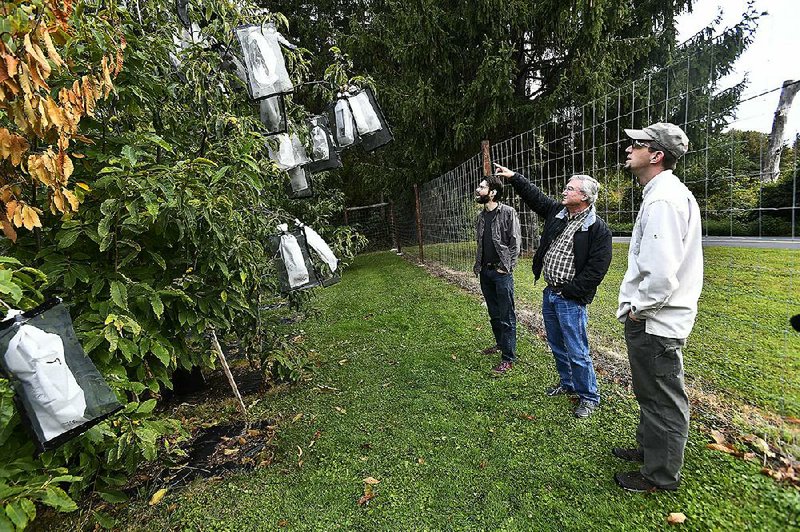SYRACUSE, N.Y. -- Chestnuts harvested from high branches on a chilly fall morning look typical: they're marble-size, russet-colored and nestled in prickly burrs, but many are like no other nuts in nature.
In a feat of genetic engineering, about half the chestnuts collected at a college experiment station feature a gene that provides resistance to blight that virtually wiped out the American chestnut tree generations ago.
Researchers at State University of New York's College of Environmental Science and Forestry soon will seek federal clearance to distribute thousands of modified trees as part of a restoration effort -- a closely watched move that could expand the frontier for genetically engineered plants beyond farms and into forests. The precedent-setting case adds urgency to a question scientists have already been grappling with:
Should genetic engineering be used in the wild to help save or restore trees?
[Video not showing up above? Click here to watch » https://www.youtube.com/watch?v=5ujL43MSn5I]
Opponents warn of starting "a massive and irreversible experiment" in a highly complex ecosystem. Proponents see a technology already ubiquitous in the supermarket that could help save forests besieged by invasive pests.
"We have this technology, it's a very powerful technology, and we can use that now to save a species," said professor William Powell, a molecular plant biologist who directs the American Chestnut Research and Restoration Project at the college.
The researchers will ask the U.S. Department of Agriculture to assess an American chestnut tree with a gene from wheat that helps it tolerate cryphonectria parasitica, a fungus unwittingly imported to the United States over 100 years ago.
The blight decimated a towering tree species once dominant in forests from Maine to Georgia. Nuts from up to 4 billion trees fattened hogs, and its sturdy wood was used to build cabins. Yet by the time Nat King Cole crooned about "chestnuts roasting on an open fire" after World War II, trees were doomed by the blight. Surviving trees today are typically shrubs sprouting from old roots, yet to be infected.
Long-running efforts to breed American chestnut trees with the blight tolerance of Chinese chestnut trees are more complicated than once appreciated. That's because the Chinese tree's tolerance comes from a suite of genes, instead of one or two.
Powell and his research partner, Charles Maynard, began working on a complementary track decades ago at the request of the New York chapter of the American Chestnut Foundation. The added wheat gene enables trees to produce an enzyme that breaks down harmful acid released by the fungus.
Right now, the trees are tightly regulated. Modified trees grow behind the fence of the college's experiment station near trees without the added gene. Researchers breed the two types of trees for genetic diversity. But flowering branch tips are covered with bags that keep pollen from blowing away. Chestnuts grow and are harvested in the same bags.
About half the chestnuts will inherit the gene, the researchers say.
The researchers will ask the USDA's Animal and Plant Health Inspection Service to evaluate the risks of the modified tree. They want the agency to lift the regulations it now imposes.
"What we have to make clear is that it's not going to be any different than the trees produced through conventional means," Powell said.
The USDA commonly authorizes genetically engineered crops. The vast majority of commercial corn and soybean acreage in the United States is used to grow crops engineered to be tolerant to herbicides or insects. There are even some genetically engineered plantation trees, such as papayas resistant to ringspot virus.
Engineered trees are not intentionally planted in the forests for conservation. That could change as genetic manipulation becomes more common and trees are increasingly threatened by climate change and invasive pests.
"If the chestnut is approved ... I think it's accurate to say that it does help pave the way for other biotech trees," said Jason Delborne, an associate professor of science, policy and society at North Carolina State University. Delborne served on a National Academies of Science, Engineering and Medicine committee that this year released a report that said biotechnology has a potential to help protect forests but recommended more study and investment.
Some scientists are concerned about the long-term effects of reintroducing a tree into the woods that can live for more than 200 years. How will the new trees interact with the species that replaced the long-gone chestnuts? What if the trees die off again in 50 years?
Forest ecosystems are incredibly complex and the current regulatory framework is not up to the task of evaluating the environmental and societal risks, said biotechnology and sustainable agriculture expert Doug Gurian-Sherman.
"I think we have to step back and ask whether our ability to manipulate things is getting ahead of our ability to understand their impacts," said Gurian-Sherman, a former senior scientist for the Union of Concerned Scientists.
Business on 11/07/2019
